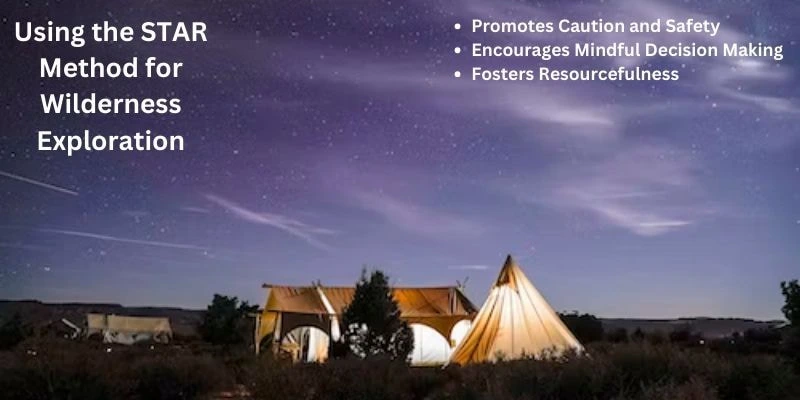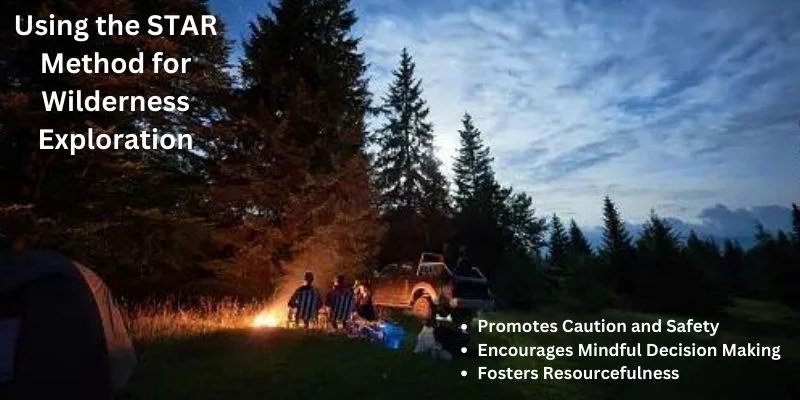Unlock 6 Hidden Gems: Using the STAR Method for Wilderness Exploration
Updated: 11 Aug 2024
192
Being outside is really fun and exciting. It’s like camping while being calm and peaceful camping in nature. However, wilderness exploration presents unique challenges that require thoughtful decision-making. Camping at Pawna Lake is like being in a beautiful picture. It’s peaceful and fun, with lots of things to do outside. You can learn a lot about yourself and the outdoors there.
The STAR method is a helpful way to figure out what to do when you’re out in the wild and don’t know what to do. It’s like a plan that helps you stay safe and smart.
Understanding the STAR Method
TSTAR means Stop, Think, Act, and Review. It’s like a guide for your brain when you’re lost or in trouble outside. It helps you make good choices.

- Stop: Don’t rush. Pausing allows you to absorb your surroundings and signals your brain to prepare for strategic thinking.
- Think: Think about what you know and can do. Look at what you have around you. Figure out if you’re safe and what you need to do next.
- Act: Once you have a plan, do things that will keep you and the place safe. Think about what you need to do first, and then do it carefully.
- Review: Think about what happened. Did your plan work? What went right? What went wrong? Learn from what happened so you can do better next time.
Six Hidden Gems of Using the STAR Method for Wilderness Exploration
1. Promotes Caution and Safety
By prioritizing the step to ‘Stop,’ explorers are encouraged to assess the risks before proceeding, reducing the likelihood of accidents.
2. Encourages Mindful Decision Making
The ‘Think’ component obliges adventurers to use critical thinking to evaluate their situation, fostering a mindset that can handle stress and uncertainty.
3. Fosters Resourcefulness
‘Act’ emphasizes taking informed, decisive steps based on available resources, thus promoting self-sufficiency.
4. Ensures Continuous Improvement
The ‘Review’ step is integral as it allows for self-assessment, ensuring that each subsequent adventure is informed by past experiences, leading to better decision-making and preparation.
5. Applicable in Varied Scenarios
Whether it’s trail navigation, wildlife encounters, or weather changes, the STAR method is versatile, providing a framework that can adapt to various circumstances.
6. Builds Confidence
By systematically working through challenges, explorers using the STAR method build confidence in their ability to handle the unpredictability of nature.
Practical Tips for Applying the STAR Method
Here are concrete ways to put the STAR method into action:
When facing an unexpected fork in the trail, stop to consult your map and compass before advancing.
If dark clouds loom ominously, think about the most immediate shelter options should the weather conditions take a turn.
Have you accidentally startled a snake? If you see a wild animal, slowly move away from it. Be kind to the animal and stay safe.
Always review your actions after any incident or decision to foster a deeper understanding of wilderness exploration and improve future responses.
“The STAR Method is a game-changer for anyone who wants to get the most out of their wilderness adventures. It encourages a proactive approach to exploration, fostering a sense of discovery and connection with the natural world.” Sarah Jones, wilderness educator
Real-life Examples of the STAR Method in Action
The STAR method isn’t just theoretical—it’s been employed successfully in numerous scenarios:
A kayaker’s experience in challenging waters teaches them to stop amid the rapids, think through the safest exit, act cautiously when navigating, and then review their course to enhance future techniques.
When it’s really snowy and you can’t see anything on a mountain, climbers stop moving so they don’t get lost. They think about how high they are and how to get away safely. Then, they use their compass to find their way. After it’s over, they think about what they did and how they can be better next time when it’s hard to see.

Share Your Wilderness Wisdom By Using Star Method
- Comment below with your personal anecdotes or insightful questions.
- Join the discussion on our forum or respond to our social media post dedicated to the STAR method.
- If you’re grappling with a specific scenario or just starting out, we’re here to help—ask your questions, and let’s explore the answers together!
The STAR Method In Finding Hidden Waterfalls in Yosemite
Have you ever dreamt of finding a cascading waterfall hidden deep within a national park? Yosemite Waterfalls are awe-inspiring natural wonders, but popular ones can get crowded. To find a secret waterfall that is just for you, you can use the STAR method. It’s a great way to explore new wilderness exploration.
| Step | Description | Example |
|---|---|---|
| Situation | Identify your starting point and overall goal for wilderness exploration. | I want to find hidden waterfalls on my next backpacking trip in Yosemite National Park. |
| Task | Define the specific task(s) involved in achieving your goal. | 1. Research potential locations of waterfalls off the beaten path. 2. Analyze topographical maps for clues like steep drops or creeks. 3. Talk to park rangers about lesser-known features. |
| Action | Detail the actions you will take to complete each task. | 1. Search online forums and guidebooks for mentions of hidden waterfalls. 2. Look for areas with significant elevation changes and converging water sources on the map. 3. Ask rangers about their experiences with undiscovered waterfalls. |
| Result | Describe the anticipated outcome of your exploration efforts. | 1. Locate a shortlist of potential waterfall locations. 2. Identify promising areas to explore on my hike based on map analysis. 3. Gain valuable insights from park rangers about hidden gems. |
Expand Your Wilderness Skills By Using Star Method
Desiring more in-depth learning? Consider enhancing your skillset with these resources:
- Enroll in Survival Skills Workshops to gain hands-on experience and practical knowledge.
- Obtain an Outdoor First Aid Certification to tackle medical emergencies with confidence.
- Take Wilderness Navigation Courses to refine your map-reading and compass skills, ensuring you stay on the right path. In fact proper use of gear essentials with star methods are helpful.
Pros and Cons of the STAR Method for Wilderness Exploration
The STAR method has emerged as a popular tool for enhancing wilderness exploration, promising to transform routine hikes into exciting discoveries. But before venturing off the beaten path, weighing its pros and cons is essential.
| Pros |
|---|
|
| Cons |
|---|
|
Conclusion
The STAR method is more than just a way to do things. It’s like building a strong base for safe camping and taking care of the outdoors. It helps you make good choices and protect nature. The STAR method can be valuable for deepening your connection with the wilderness and enriching your outdoor adventures. However, it’s crucial to approach it cautiously, prioritizing safety and acknowledging the learning curve involved.
he best way to explore is to have fun and feel good about being in nature. The STAR method can help you stay safe and enjoy your adventures even more. So, the next time you pack your bag and go on a trip, remember to use the STAR method to help you on your journey.
FAQs
How does the STAR method assist in the management of risk during wilderness exploration?
The STAR method helps people who like to explore be careful. It teaches them to stop and think before they do something, then do it safely, and finally, learn from what happened. This helps them stay safe and avoid trouble.
Can the STAR method be applied to urban adventures, such as city exploration or parkour?
Yes, while the STAR method is tailored for wilderness exploration, its principles are universal. The method can help manage risks and make informed decisions in any environment where uncertainties are present, including urban settings.
How can the STAR method benefit someone with extensive experience in outdoor activities?
Even for the seasoned adventurer, the STAR method serves as a reinforcing structure that ensures no critical steps in decision-making are overlooked, promotes a disciplined approach to problem-solving, and facilitates continuous improvement.
Will the STAR method make my adventures less adventurous?
Not at all. Using the STAR method doesn’t mean you can’t have fun or be excited. It actually makes adventures better because you’re ready for anything. It helps you make smart choices to do fun and challenging things safely.
How do I teach the STAR method to children or beginners in outdoor activities?
Start with simple, relatable scenarios and role-play exercises to demonstrate each step of the STAR method. Gradual introduction during real outdoor experiences, with guidance and reinforcement, will help ingrain the practice.
Please Write Your Comments